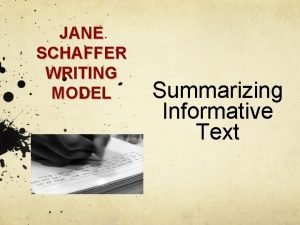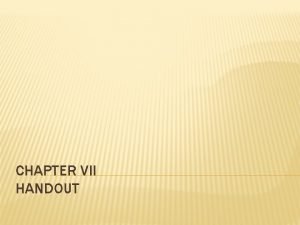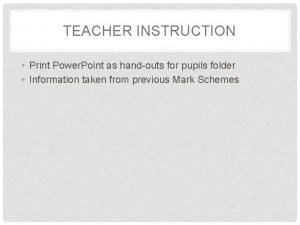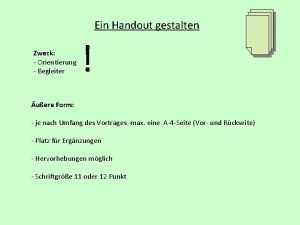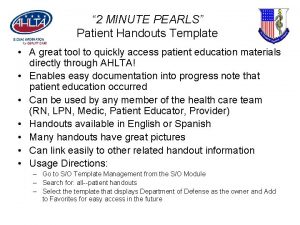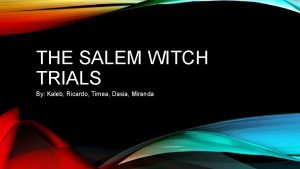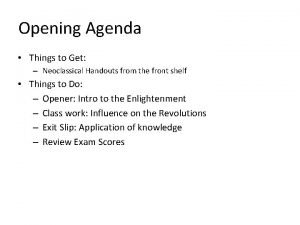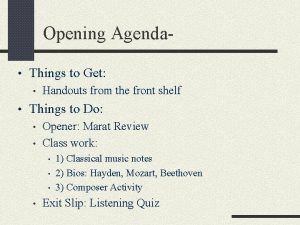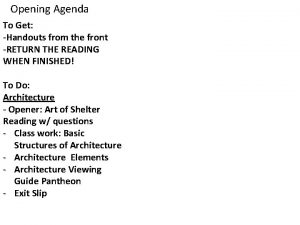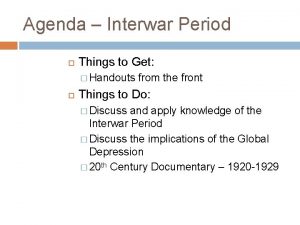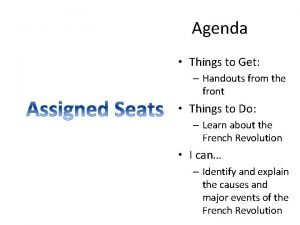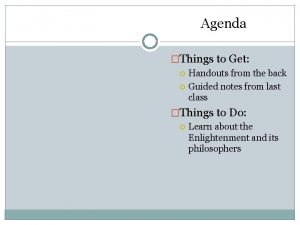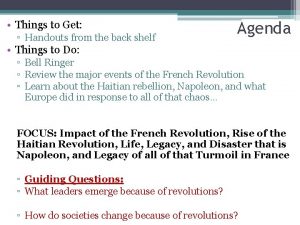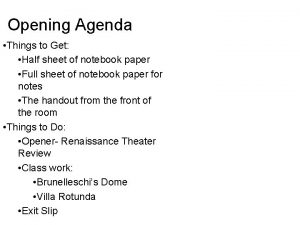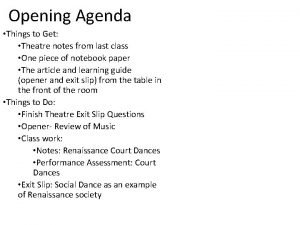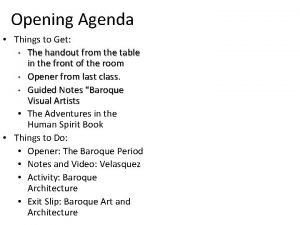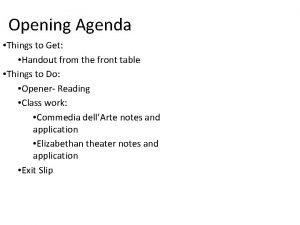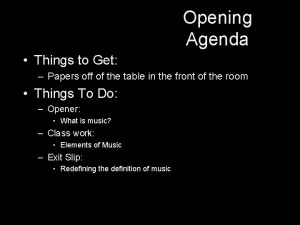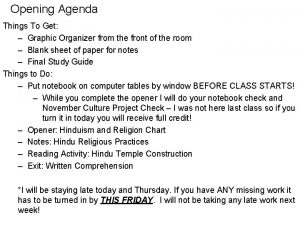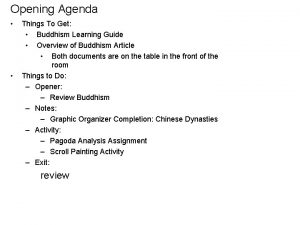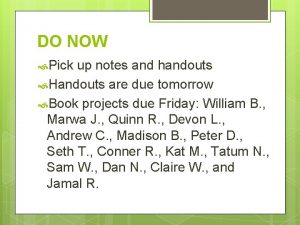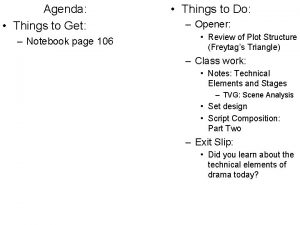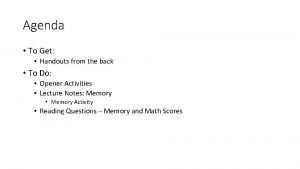Opening Agenda Things to Get The 2 handouts






























- Slides: 30

Opening Agenda • • Things to Get: • The 2 handouts from the table in the front of the room • Notebook paper Things to Do: • Opener: Preview of Baroque Art • Notes: Baroque art and artists • Exit Slip: Characteristics and Controversies of Baroque Art in Review

Opener n Using the article provided, answer the questions on your learning guide provided. The Conversion of St. Paul, 1601 http: //www. americancatholic. org/features/saint. aspx? id=1271#tag. Audi o

Baroque 1600 -1750 n The Baroque period began in 1600. n The church wanted to attract new worshippers by overwhelming them with theatrical, “must see” architecture.

The Baroque Era-What’s happening in the world? n 30 Years War n n Started out as a religious war between the Catholics & Protestants in the Holy Roman Empire but changed to a political war involving the following countries and regions: the Ottoman Empire, Austria, Poland, the Netherlands, Germany, Denmark, France, Spain, & Sweden n Results: Treaty of Westphalia and a rise in nationalism Protestant Reformation/Catholic (Counter) Reformation n Martin Luther “thesis” against the Catholic Church n Influences Art: n Catholic- religious subject matter n n Popes wanted to remake Rome as the cultural center of the western world. Council of Trent suggested that religious art: be directed toward clarity, realism, and emotion to increase understanding, make it more meaningful to everyday life, and to arose piety and fervor. Protestant- avoids religious subjects in favor of landscapes, etc. Increased Trade n n n New wealth= new patrons beyond courts and churches New Science theories n Sun at the center of the universe n n New desires- growth of slavery

Baroque Period Visual Art * Introduction • Caravaggio, Rembrandt, Bernini & Velasquez

Baroque 101 Art Style n n n Most sumptuous and ornate in the history of art Art was expanded into everyday life. Light was used to create an emotional impact. Classical elements were used without classical restraint Visual art was supposed to speak to the illiterate rather than the well-informed. http: //clancyslover. com/wpcontent/uploads/2009/03/judith-slaying-holofernes. jpg http: //www. michaelarnoldart. com/bernini_david. jpg http: //www. students. sbc. edu/gregg 09/Versailles%20 images/Versailles%203. jpg

The Conversion of St. Paul Las Meninas Ecstasy of St. Teresa The Night Watch

Baroque Visual Art Overview n Baroque: n Started in Italy n Comes from the term “barrocco” n A Portuguese word meaning “irregularly shaped pearl”

Baroque Visual Art n Although started in Italy, became an international phenomenon Mercantile class and Absolute monarchs are the patrons outside of Italy n Catholic Church: n n Wanted to establish Rome as the cultural center of the Western world Role of art: Art should be used to teach to the illiterate Protestants: n Role of Art: Worshippers should rely on the Bible to learn about the gospel… not art.

Baroque Visual Art: Function and Characteristics n n Most sumptuous and ornate in the history of art Art was expanded into everyday life. Visual art was supposed to speak to the illiterate rather than the well-informed. Light was used to create an emotional impact. n Chiaroscuro Italian for “light-dark” n a bold contrast between light & dark. n n Tenebrism Italian for "murky" n It creates the look of figures emerging from the dark. n which is a heightened form of chiaroscuro. n


Michelangelo Merisi da CARAVAGGIO 1573 -1610 n http: //static. artbible. info/large/carav_david_goliath. jpg

n Michelangelo Merisi da CARAVAGGIO 1573 -1610 Probably the most revolutionary artist of his time n Characterized by his temper n n n Received pardon and died two days later He did not idealize the human and religious experience. n n imprisoned for several assaults and for killing a man Considered profane/vulgar Orphaned at age 11, went to Rome in 1588, and found a patron in Cardinal Francesco del Monte. n First commissions: scenes of the life of St. Matthew The Crucifixion of Saint Peter, 1601

Caravaggio n The Calling of St. Matthew- 1509 -1602 http: //www. shafe. co. uk/crystal/images/lshafe/Caravaggio_The_Calling_of_St_Matthew_1599 -1600. jpg The works caused public outcry because of their realistic and dramatic nature.

n The Conversion of St. Paul, 1601

Michelangelo’s Conversion of Saul

The Conversion of St. Paul n n Subject: n St. Paul hears the word of God; falls off his horse and is blinded by the bright light of God Significance: n Religious art was secularized n Saints and miracles appeared to be ordinary events Elements and Principles of Art: n The audience is brought into the action through the use of chiaroscuro, tennebrism, and perspective. Controversies n “down and dirty” style n St Paul is on the ground, and you see the horse’s rear

Rembrandt HARMENSZOON VAN RIJN 1606 -1669 n http: //www. liverpoolmuseums. org. uk/picture-ofmonth/graphics/large/rembrandt_self-portrait. jpg

Biography n n n 1629 1606 -1669 Born in Leyden; son of a miller 1634: Marries Saskia van Ulenborch 1634 -1642: extremely successful 1642: Saskia dies -> turning point in art 1640 His paintings are characterized by luxurious brushwork, rich color, and a mastery of chiaroscuro http: //emptyeasel. com/wp-content/uploads/2007/02/rembrandt-selfportrait-1629. jpg http: //www. mystudios. com/rembrandt/works/rembrandt-sp-1640. jpg

Characteristics of Art work n n n Supper at Emmaus (1648) n n The Anatomy Lesson of Dr. Nicolaes Tulp (1632) the greatest artist of the Dutch school Painter, draftsman, and etcher of the 17 th century; His paintings are characterized by luxurious brushwork, rich color, and a mastery of chiaroscuro Numerous portraits and self-portraits exhibit a profound penetration of character. n Between 50 -60 Early career: n He received many commissions for portraits as well as for paintings of religious subjects

Rembrandt The Militia Company of Captain Frans Banning Cocq n Rembrandt was at his most inventive in this work, popularly known as The Night Watch, 1642. n Complete the questions on your learning guide as you travel around the room to read the articles covering the Night Watch.

Rembrandt n n The Militia Company of Captain Frans Banning Cocq Rembrandt was at his most inventive in this work, popularly known as The Night Watch, 1642. Each man is painted with the care that Rembrandt gave to single portraits, yet the composition is such that the separate figures are second in interest to the effect of the whole.

Rembrandt The Militia Company of Captain Frans Banning Cocq The Night Watch: 1642 n Subject summary: n n Elements of Art: n n painting moves in diagonals (figures walking toward the center- implied movement) Controversies: n n n Shows Cocq’s company welcoming Marie de’ Medici’s (Queen of France) morning arrival at Amsterdam’s city gate Patrons contributed equally to the cost of the painting; however, not all are represented equally Original title was Captain Frans Banning Cocq Mustering His Company but called the Night Watch in 1700’s because it had darkened with age Connection to Artist: n Turning Point: Declining interest in his work and financial problems

Gianlorenzo Bernini 1598 -1680 n http: //blogs. guardian. co. uk/art/bernini 460. jpg

Italian Baroque Art/Architecture n Gianlorenzo Bernini -1598 -1680 -sculptor/architect -last of great artists to work for the popes -Major works: - St. Peter’s Piazza - David - Ecstasy of St. Teresa (and Cornaro Chapel)

Cornaro Chapel

Ecstasy of St. Teresa An Angel and a Nun.

The Ecstasy of St. Teresa 1645 -52 n n The entire chapel is designed to show this sculpture off (there are painted balconies on the wall with spectators). The sculpture depicts St. Teresa when she sees a vision and hears voices (notice her face). The saint and angel appear to be on swirling clouds, light created on the side of the wall, the marble quivering… The entire pieces shows emotion, drama, and passion.


Exit Slip n Complete the chart you began for your opener using the notes you took during this class. Artist Caravaggio Rembrandt Bernini Artwork Subject Baroque Characteristics Controversies or Cool Facts
 Get on get off get into get out of
Get on get off get into get out of One direction figurative language
One direction figurative language Agenda sistemica y agenda institucional
Agenda sistemica y agenda institucional Www.studenthandouts.com
Www.studenthandouts.com Jane shaffer
Jane shaffer Student handouts inc
Student handouts inc Cs408 handouts
Cs408 handouts Gapped handouts
Gapped handouts Slide samples
Slide samples Handout definition
Handout definition Advantages and disadvantages of handouts
Advantages and disadvantages of handouts Ein handout gestalten
Ein handout gestalten Www.studenthandouts.com
Www.studenthandouts.com Zoo103 handouts pdf
Zoo103 handouts pdf Disadvantages of newspaper
Disadvantages of newspaper Patient handout template
Patient handout template Cs408 handouts
Cs408 handouts What is selection in pseudocode
What is selection in pseudocode Get up get moving quiz
Get up get moving quiz Get focused get results
Get focused get results Get up get moving quiz
Get up get moving quiz Get up get moving quiz
Get up get moving quiz Get up get moving
Get up get moving What sort of evidence was used to arrest accused witches
What sort of evidence was used to arrest accused witches Question to get to know someone
Question to get to know someone Whats an energy pyramid
Whats an energy pyramid Movement
Movement Phép trừ bù
Phép trừ bù Chúa sống lại
Chúa sống lại Hươu thường đẻ mỗi lứa mấy con
Hươu thường đẻ mỗi lứa mấy con đại từ thay thế
đại từ thay thế




